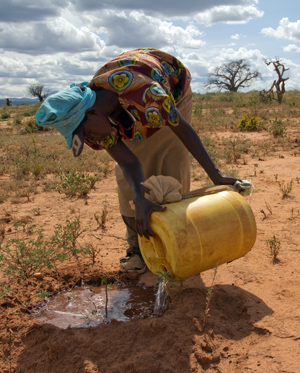
Share
Related Links
Turn Down the Heat: Why a 4C world must be avoided (Dec 2012, PDF)
Attachments
Landscape%20Approach_ERin%20Gray_9.23.13_0.pdf
Keywords
Authors/Partners
Worldbank, Terrafrica, FAO, IFPRI, ILRI, ICARDA, CIRAD
Contributions to the Economics of Drylands Resilience in Sub-Saharan Africa
CHALLENGE
In Africa, dryland regions make up 43% of the total land area, account for 75% of the area used for agriculture (defined to include production of both crops and animals), and are home to 50% of the population. Poverty is heavily concentrated in dryland regions; about 75% of Africa’s poor people live in countries in which at least one-quarter of the population lives in dryland zones. By 2030, the number of Africans living in dryland regions will increase from 460 to almost 800 million, putting increased pressure on the natural resource base and leading to increased competition for land and water resources.
The challenge of successfully developing the dryland regions of Africa is compounded by their inherent fragility. Most African drylands are subject to frequent and severe climate shocks, and many have limited agricultural potential due to their inherently poor soils, forbidding topography, and inclement weather. The disparity between dryland areas and other areas in Africa that benefit from more plentiful and more regular rainfall threatens to widen. Many African drylands have continued to stagnate, even as other areas within the region have started to grow. The attention, energy, and financial resources of governments, development partners, and civil society are often absorbed by the need to respond quickly to humanitarian emergencies caused by climatic shocks, social conflict, or both, leaving few resources to build resilience and establish the basis for sustained growth
APPROACH
A paradigm shift is needed in the approach to drylands development. In this context, the World Bank has teamed up with a number of partners (TerrAfrica, Food and Agriculture Organization of the United Nations (FAO), International Food Policy Research Institute (IFPRI), International Livestock Research Institute (ILRI), International Centre for Agricultural Research in Dry Areas (ICARDA), and Agricultural Research for Development (CIRAD/SIPSSA) to prepare a report on “The Economics of Drylands Resilience in Sub-Saharan Africa,” designed to contribute to the ongoing dialogue among policy makers and development practitioners about measures to reduce the vulnerability and enhance the resilience of populations living in drylands regions of sub-Saharan Africa
PROFOR will support a specific component of this report by focusing on the contributions of the landscape approach and tree-based systems. The assessment of the landscape approach will consider the various land and natural resource users within a landscape and actors outside the landscape that influence the goods or products obtained from a landscape and the ecosystems within it. The assessment of tree-based systems in African drylands will include an estimation of the areas in which the most promising tree-based systems could be introduced and projections of how these areas are likely to change in the medium and longer terms.
RESULTS
Preliminary finding have been obtained from the analysis and research conducted so far. The draft reports contain the following information:
Landscape approach
- The barriers to overcome before a landscape approach will be part of regular policymaking and development planning include (1) Understanding of and support for a landscape approach is still aspirational for many actors who require more evidence on the practical components of the approach and need more guidance on terminology and approaches; (2) Analysts and decision-makers are confronted with too many concepts and definitions spread across disciplines; (3) Understanding of landscape approaches has been fragmentary; (4) There are no simple solutions for these complex challenges and they require a learning-by-doing approach Sayer at al.2013; (5) A landscape approach does not automatically lead to sustainability; and (6) There is a lack of awareness and knowledge about a landscape approach on the part of national and local governments, the private sector, and civil society in developing countries.
- Some stakeholders’ interests might conflict with other stakeholders in a landscape approach. For example, agricultural producers’ interests might conflict with pastoralists’ interests if a landscape approach requires a grazing ban or livestock enclosures that require livestock keepers to use new routes or new sources of fodder.
Tree-based systems
The term “tree-based systems” is defined in the context of the report as agricultural (cropping) systems, forest/woodland/bushland systems or pastoral (rangeland) systems in which trees play a significant economic role.
The three pillars of the African drylands conceptual framework through which tree-based systems can reduce vulnerability and increase resilience of households living in drylands environments are exposure to shocks, reducing sensitivity to shocks, and increasing coping capacity. The report cites examples where many households acting together can achieve landscape-level effects that do in fact reduce exposure. For example, the landscape-scale regeneration of medium-to-high density tree populations in south central Niger has significantly reduced the severity of windstorms at the beginning of the growing season. Reducing sensitivity involves actions taken by households before a shock hits. For example, a diverse portfolio of trees can enhance a household’s ability to cope with stresses because the products will mature at different times during the year. Likewise, there is a range of options that households can tap into after a shock hits their coping capacity. For example, trees can be cut and sold for cash in times of need.
Another potential solution in the drylands is farmer-managed natural regeneration, in which farmers manipulate the natural biological regeneration of trees on farms into a cycle that suits them. This activity is ongoing. Findings will be shared on this page when they become available.
For stories and updates on related activities, follow us on twitter and facebook , or subscribe to our mailing list for regular updates.
Author : Worldbank, Terrafrica, FAO, IFPRI, ILRI, ICARDA, CIRAD
Last Updated : 06-15-2024








